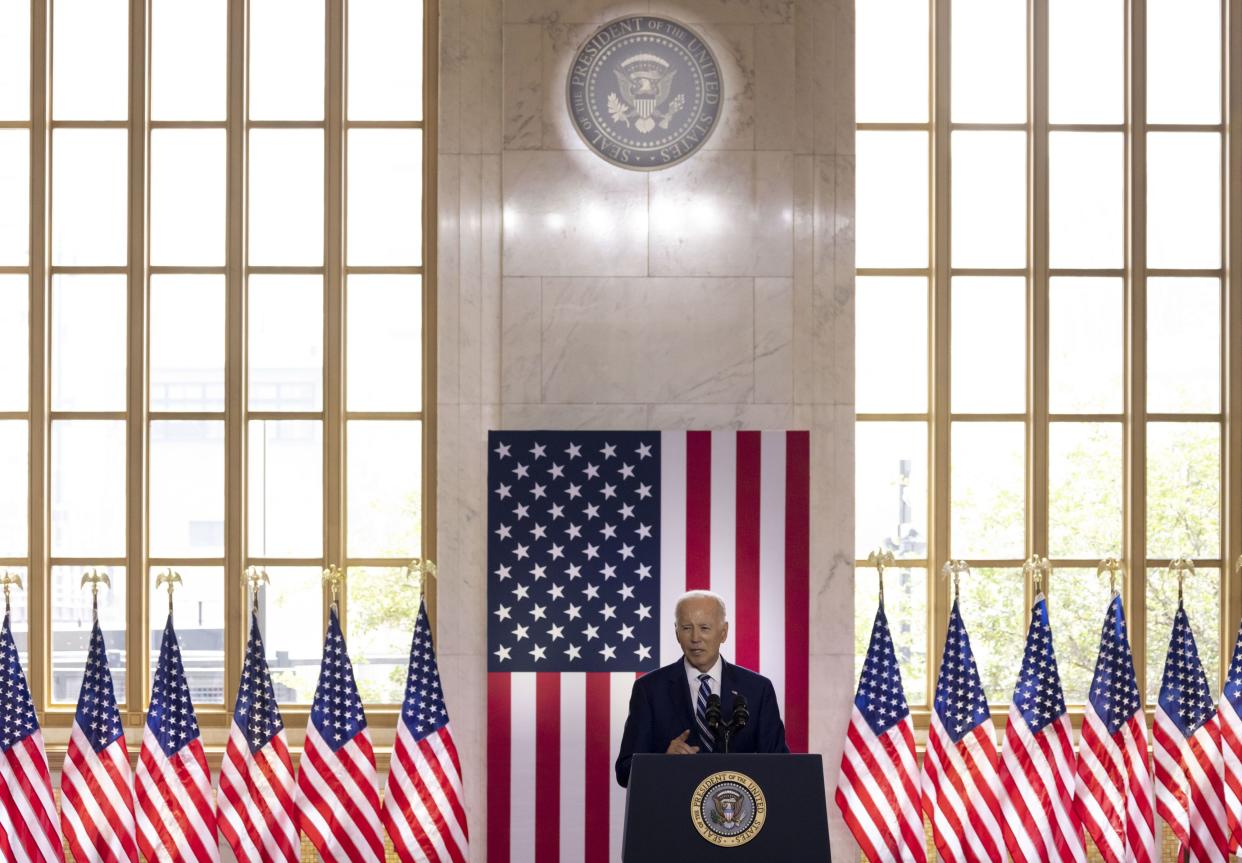Editorial: Was it ‘Bidenomics’ that brought down inflation?

- Oops!Something went wrong.Please try again later.
In a major economic policy speech in the lobby of Chicago’s old main post office in June, President Joe Biden enthusiastically branded his economic growth strategy as “Bidenomics,” a term that was basically created by The Wall Street Journal and the Financial Times but, like “Obamacare,” has been embraced by Democrats as if it were Biden’s idea all along. “Bidenomics” sounds a lot like Biden’s traditional liberalism, an updated version of Franklin D. Roosevelt’s New Deal or Lyndon B. Johnson’s Great Society.
Despite Biden presiding over a generally improving economic picture, his reelection bid has needed all the help it can get. His approval ratings have been stubbornly tepid, particularly on the economy, recently sinking close to the lowest level of his presidency after the Supreme Court killed his $400 billion student loan forgiveness plan. And the political temperature is rising: July 1 marked a time on the calendar that falls halfway between last year’s midterm elections and next year’s far more consequential presidential election with an astonishingly unbloodied Donald Trump on the attack, his federal indictments notwithstanding.
Wednesday bought good news for the White House, though. The U.S. inflation rate fell to 3% in June, thanks to improvements in the prices of gasoline, airline fares, used cars and groceries, The Associated Press reported. That might not be the 2% the Federal Reserve says it ultimately wants, and interest rates still are expected to rise yet further this month. But it’s a big difference from the 4% rate reported in May and, of course, the much steeper inflation rates in previous months that have given Americans sticker shock everywhere from their local fast-food outlet to the bill for the plumber.
Even though most of this decrease was attributable to the easing of supply problems, which were a consequence of the war in Ukraine and the pandemic, not to mention the actions of the Federal Reserve, the White House still moved fast to attribute this to “Bidenomics,” also touting record job growth and billions of dollars in new infrastructure investments on top of an uncommonly fast comeback in manufacturing.
One month’s decrease in inflation, though, is hardly a roaring endorsement for Bidenomics, whatever it means, nor is it likely to turn around those approval ratings. After dealing with record-high inflation, rises in the cost of living, slumps in real wages and rises in interest rates in response to inflation, the moderate and independent voters sought by both parties are not easily impressed by slogans, if they ever were.
And, of course, those paying attention know that the runaway inflation rate was caused by government giveaways during the pandemic: Biden’s shoddily managed relief packages, especially toward the end of the COVID-19 crisis, were much too generous, upsetting economic equilibrium. What we’re really seeing now is the economy finally working the Biden spending, and that of the prior Trump administration, out of the system. Some semblance of normalcy finally appears to be returning.
Still, Biden has been talking like a president with plenty to boast about.
“Today, the U.S. has had the highest economic growth among the world’s leading economies since the pandemic,” he said in Chicago. “We’ve added over 13 million jobs, more jobs in two years than any president has added in a four-year term.”
And he added, 800,000 of those jobs were in the manufacturing sector, which matters very much to voters here in the industrial heartland.
At this point in the political cycle, Biden’s biggest risk may be that the voters aren’t paying attention all that closely. Even with growing attention to presidential contests in both parties, it’s too early to expect a lot of change in support for the top offices; in July, many Americans are off enjoying the outdoors.
Still, we’ve long pointed out the pernicious dangers of high inflation, a curse that eats up the savings of older Americans, negates the purchasing power of hard-won wage gains and can serve as a cover for the kind of price increases that have been emptying consumers’ pockets.
It looks to us like the Fed can at least pause the further rate increases widely predicted for later this year and wait to see whether those June numbers hold on a longer-term basis. Politics are all about dodging responsibility for bad news and claiming credit for the good, and that’s what you can see going on here. If Bidenomics has now brought inflation down, Biden also has to admit it helped to push inflation higher in the first place.
But Wednesday’s news was very good indeed: Not many months ago, a 3% inflation rate seemed like a pipe dream. Americans of all political stripes should be glad that the Fed has seen some summer success and that supply chains now appear less overwhelmed.
However you want to call it, what we’re really seeing is the latest chapter in the market-driven story of American recovery.
Join the discussion on Twitter @chitribopinions and on Facebook .
Submit a letter, of no more than 400 words, to the editor here or email letters@chicagotribune.com .

